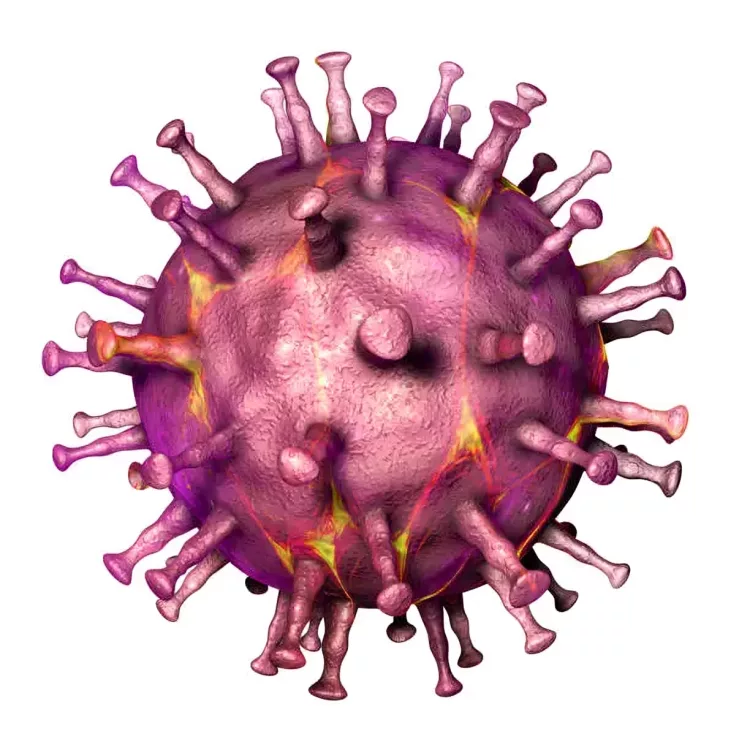African Swine Fever is a severe disease that develops in pigs by the African Swine Fever Virus. The increasing number of cases since 2007 has made this disease a serious threat. This fever ranges from mild to severe symptoms, and pigs with serious and prolonged symptoms usually die, clearly showing the harmful effects of the ASF virus.
What is African Swine Fever?
This fever affects domestic pigs due to the ASF virus. Giving pigs undercooked food is a primary cause of African swine fever. It is a highly contagious and complicated disease, as it can spread from one pig to another and kill a whole herd of them. This is not easy to treat and manage, and no vaccine is available. Some cases of this fever are also reported in wild boars, but transmission of the virus into humans is impossible.1Li, Z., Chen, W., Qiu, Z., Li, Y., Fan, J., Wu, K., Li, X., Zhao, M., Ding, H., Fan, S., & Chen, J. (2022). African Swine Fever Virus: A Review. Life (Basel, Switzerland), 12(8), 1255. https://doi.org/10.3390/life12081255
How does African Swine Fever spread?
It spreads when a virus enters the pigs’ body by eating contaminated food. Pigs infected with this fever shed the virus almost 2 days before any symptoms through their body secretion such as saliva, feces, and urine. If infected pigs get into a fight with another pig or have bloody diarrhea, the chance of transmission of this fever increases. ASF can also spread through inhalation. The ASF virus can remain in the tissues even in a dead pig, which is why feeding an undercooked pig to another animal is also a factor in its transmission.
Some species of soft-shell ticks, such as Orthinodoros, are also responsible for transferring this fever into pigs.

Nonliving things that come into contact with infected pigs, such as clothes, knives, and other equipment, are also sources of this fever in pigs and boars.
How common is African Swine Fever?
The first case was reported in East Africa in 1900. From there, it spread to other countries, such as Portugal, some European countries, and Brazil. In 2014, it affected the pigs in the European Union and Poland. This fever reached China in 2018 and drastically infected the pigs, including 178 outbreaks. After China, this fever spread to North Korea, Vietnam, and the Philippines. In 2023, some cases were also reported in wild boars. According to reports from March 2024, most of the affected pigs died, affecting the availability of pigs throughout the world. Early reporting of this fever can save domestic pigs and boars from the virus.
Causes
The leading cause behind this fever is a virus called Asfarviridae. Almost 20 species of this fever are present nowadays. That is why it is not easy to treat this disease. The virulence of the ASF virus depends upon its genotype; the genotype ll is by far the most dangerous serotype present.2Njau, E. P., Machuka, E. M., Cleaveland, S., Shirima, G. M., Kusiluka, L. J., Okoth, E. A., & Pelle, R. (2021). African Swine Fever Virus (ASFV): Biology, Genomics and Genotypes Circulating in Sub-Saharan Africa. Viruses, 13(11), 2285. https://doi.org/10.3390/v13112285

Symptoms
Symptoms of this fever develop gradually in four stages:
- Pre-acute
- Acute
- Subacute
- Chronic
The stages determine the virulence and prognosis of African swine fever. The first two stages present severe signs and symptoms of hemorrhagic disease. The mortality rate of pigs in pre-acute and acute stages is 100%.
The incubation period of this fever is 4-7 days, after which the infected pigs start showing symptoms such as high grades of fever. Along with fever, pigs develop incoordination and prostration. Many pigs die at this stage, and those who survive exhibit hemorrhagic signs like cyanosis of the ears and hyperemia of the body. Severe cases of this fever develop bleeding from the nose and anus of the pigs as well as vomiting. Pregnant pigs in these stages usually undergo an abortion.
Pigs rarely recover from African swine fever, as the disease typically results in high mortality rates. However, in cases where pigs survive the acute phase, they may either appear to recover completely or become chronic carriers of the virus. Chronically infected pigs may develop gross lesions in their lymph nodes, as well as in other organs, such as the heart and kidneys.
Some pigs may develop fluid in pericardial, pleural, and peritoneal cavities.3Yoon, H., Hong, S. K., Lee, I., Yoo, D. S., Jung, C. S., Lee, E., & Wee, S. H. (2020). Clinical symptoms of this fever in domestic pig farms in the Republic of Korea, 2019. Transboundary and emerging diseases, 67(5), 2245–2248. https://doi.org/10.1111/tbed.13552
Diagnosis
Diagnosis of this fever is a little tricky because every infected pig exhibits different signs and symptoms. Clinical signs and symptoms of this fever also resemble other diseases, such as salmonellosis or erysipelas.4Hu, Z., Tian, X., Lai, R., Wang, X., & Li, X. (2023). Current detection methods of ASF virus. Frontiers in veterinary science, 10, 1289676. https://doi.org/10.3389/fvets.2023.1289676
A combination of clinical observation, sampling, and laboratory techniques is essential for an accurate diagnosis.
Tissue Sampling:
Samples are typically taken from the spleen, lymph nodes, tonsils, liver, and kidneys of infected pigs. Among these, the spleen and lymph nodes often show the highest viral loads, making them ideal for detecting ASF virus.
Bone Marrow Examination:
ASF virus can also be detected in the bone marrow, where nucleic acids associated with the virus are concentrated.
Chronic Cases:
In chronic ASF cases, the virus often resides in joint tissues. Examining intra-articular tissues can help identify the virus in these cases.
Cell Culture & Hemadsorption:
Bone marrow leukocyte or blood monocyte cultures are valuable diagnostic tools. ASF virus induces hemadsorption of red blood cells, a characteristic feature used for identification.
Molecular Diagnostics:
-
PCR (Polymerase Chain Reaction):
Highly sensitive and specific, PCR is used to detect ASF virus nucleic acids.
-
Immunofluorescence:
Detects viral antigens in tissue samples.
Serological Tests:
Surviving pigs may develop antibodies to the ASF virus. Techniques such as ELISA (enzyme-linked immunosorbent assay), immunoblotting, and indirect immunofluorescence are used to detect these antibodies.
Rapid Penside Tests:
Lateral flow devices provide quick, on-site diagnostic results, which are especially useful for outbreak investigations.5Zhong, K., Zhu, M., Yuan, Q., Deng, Z., Feng, S., Liu, D., & Yuan, X. (2022). Development of an Indirect ELISA to Detect ASF Virus pp62 Protein-Specific Antibodies. Frontiers in veterinary science, 8, 798559. https://doi.org/10.3389/fvets.2021.798559

What is the treatment of African Swine Fever?
There is no specific and effective treatment for African swine fever. Many scientists are working to make a valuable vaccine to treat this fever and control pigs’ death rates due to ASFV. Two live vaccines have been developed but are insufficient to eliminate the disease. The reason behind vaccine failure is the presence of 24 different genotypes of the ASF virus. The live vaccine can treat the homologous cases of African swine fever, and the other heterozygous strain can kill the entire community of domestic pigs.
Moreover, vaccines for this fever must be checked thoroughly to avoid the associated complications such as chronic viremia.6Zhang, H., Zhao, S., Zhang, H., Qin, Z., Shan, H., & Cai, X. (2023). Vaccines for African swine fever: an update. Frontiers in microbiology, 14, 1139494. https://doi.org/10.3389/fmicb.2023.1139494
How to control African Swine Fever?
Since no satisfactory treatment is available for African swine fever, we can only opt for effective preventive methods to control the transmission of the virus.
Early detection of the ASF virus with the help of early detection tests, such as color-changing paper strips and blood samples, is by far the most convincing way to control the disease in the domestic and wild pig population.
Quarantine for pigs with this fever helps prevent the spread of the virus in other pigs. The use of fences and dedicated footwear also allows less transmission of the virus. To further facilitate the control of African swine fever, people make solid walls to avoid the entry of Ornithodoros ticks. Another method of prevention is to heat the pig’s swill for at least 30 minutes before feeding them. Heating the swill kills the ASF virus and protects the herd. Many areas of the world eradicated the this fever by slaughtering the infected virus and other animals that get infected by it.
Another way to prevent transmission is to disinfect the tools used while hunting pigs thoroughly. It is helpful in adequately monitoring the food given to pigs and destroying the waste rather than feeding it to animals.7Liu, Y., Zhang, X., Qi, W., Yang, Y., Liu, Z., An, T., Wu, X., & Chen, J. (2021). Prevention and Control Strategies of African Swine Fever and Progress on Pig Farm Repopulation in China. Viruses, 13(12), 2552. https://doi.org/10.3390/v13122552
Prognosis of African Swine Fever
The prognosis entirely depends upon its stage. During the acute and preacute stages, infected pigs experience severe hemorrhagic signs, and the mortality rate exceeds 100% in these stages of African swine fever. The prognosis of sub-acute cases of this fever is relatively good. The mortality rate increases more when there is a sudden entry of a virus into a new region. With proper evaluation and early diagnosis of African swine fever, its prognosis can be made better. Moreover, isolating the infected animals and taking the necessary precautions can control African swine fever’s morbidity and mortality rate.8Ruedas-Torres, I., Thi To Nga, B., & Salguero, F. J. (2024). Pathogenicity and virulence of African swine fever virus. Virulence, 15(1), 2375550. https://doi.org/10.1080/21505594.2024.2375550
Can the African Swine Fever virus survive in feces?
Yes. The ASF virus remains active in the feces of infected animals and can also be transmitted to other animals. Studies have shown that the ASF virus remains communicable in faeces for at least eleven days in a favourable environment.
Difference between Classical Swine Fever & African Swine Fever
Classical swine and African swine fevers infect pigs similarly, and some signs and symptoms, such as fever, cough, and hemorrhage, are similar. However, they differ from each other in many ways.
The cause of both diseases is a virus, but it is caused by different families. Ticks and rodents transmit African swine fever, while classical swine fever doesn’t. The symptoms of Classical swine fever are primarily related to the brain, while ASFV doesn’t show such symptoms.
In terms of treatment, no specific vaccine has been made yet for African swine fever, but scientists have created an effective vaccine to treat classical swine fever.9Manessis, G., Frant, M., Podgórska, K., Gal-Cisoń, A., Łyjak, M., Urbaniak, K., Woźniakowski, G., Denes, L., Balka, G., Nannucci, L., Griol, A., Peransi, S., Basdagianni, Z., Mourouzis, C., Giusti, A., & Bossis, I. (2024). Label-Free Detection of African Swine Fever and Classical Swine Fever in the Point-of-Care Setting Using Photonic Integrated Circuits Integrated in a Microfluidic Device. Pathogens (Basel, Switzerland), 13(5), 415. https://doi.org/10.3390/pathogens13050415
Is pork with ASF safe to eat?
African swine fever is entirely a disease of animals such as pigs and wild boars, and it doesn’t affect humans in any way. Therefore, it is safe for humans to consume pig meat in any form.
Can heating kill the African Swine Fever virus?
ASF virus can survive for an extended period in the meat of infected animals. However, you can inactivate the virus before eating the meat by heating it at 70 degrees Celsius for at least 30 minutes.
Can African Swine Fever be transmitted through the air?
Yes. this fever can be transmitted from one animal to another through nasal and oral secretions.
Conclusion
In conclusion, this fever is viral in origin and is a dangerous disease with a lousy prognosis, mainly depending on the stage. It can kill herds of pigs and boars due to the lack of effective treatment. The prominent cause behind this fever is genetic. There is no specific treatment for this fever, so taking adequate precautions in the early stages is the only way to control the disease. Taking care of the food given to pigs, slaughtering the infected pigs, or putting them in quarantine for some days helps decrease the mortality rate of African swine fever.
Refrences
- 1Li, Z., Chen, W., Qiu, Z., Li, Y., Fan, J., Wu, K., Li, X., Zhao, M., Ding, H., Fan, S., & Chen, J. (2022). African Swine Fever Virus: A Review. Life (Basel, Switzerland), 12(8), 1255. https://doi.org/10.3390/life12081255
- 2Njau, E. P., Machuka, E. M., Cleaveland, S., Shirima, G. M., Kusiluka, L. J., Okoth, E. A., & Pelle, R. (2021). African Swine Fever Virus (ASFV): Biology, Genomics and Genotypes Circulating in Sub-Saharan Africa. Viruses, 13(11), 2285. https://doi.org/10.3390/v13112285
- 3Yoon, H., Hong, S. K., Lee, I., Yoo, D. S., Jung, C. S., Lee, E., & Wee, S. H. (2020). Clinical symptoms of this fever in domestic pig farms in the Republic of Korea, 2019. Transboundary and emerging diseases, 67(5), 2245–2248. https://doi.org/10.1111/tbed.13552
- 4Hu, Z., Tian, X., Lai, R., Wang, X., & Li, X. (2023). Current detection methods of ASF virus. Frontiers in veterinary science, 10, 1289676. https://doi.org/10.3389/fvets.2023.1289676
- 5Zhong, K., Zhu, M., Yuan, Q., Deng, Z., Feng, S., Liu, D., & Yuan, X. (2022). Development of an Indirect ELISA to Detect ASF Virus pp62 Protein-Specific Antibodies. Frontiers in veterinary science, 8, 798559. https://doi.org/10.3389/fvets.2021.798559
- 6Zhang, H., Zhao, S., Zhang, H., Qin, Z., Shan, H., & Cai, X. (2023). Vaccines for African swine fever: an update. Frontiers in microbiology, 14, 1139494. https://doi.org/10.3389/fmicb.2023.1139494
- 7Liu, Y., Zhang, X., Qi, W., Yang, Y., Liu, Z., An, T., Wu, X., & Chen, J. (2021). Prevention and Control Strategies of African Swine Fever and Progress on Pig Farm Repopulation in China. Viruses, 13(12), 2552. https://doi.org/10.3390/v13122552
- 8Ruedas-Torres, I., Thi To Nga, B., & Salguero, F. J. (2024). Pathogenicity and virulence of African swine fever virus. Virulence, 15(1), 2375550. https://doi.org/10.1080/21505594.2024.2375550
- 9Manessis, G., Frant, M., Podgórska, K., Gal-Cisoń, A., Łyjak, M., Urbaniak, K., Woźniakowski, G., Denes, L., Balka, G., Nannucci, L., Griol, A., Peransi, S., Basdagianni, Z., Mourouzis, C., Giusti, A., & Bossis, I. (2024). Label-Free Detection of African Swine Fever and Classical Swine Fever in the Point-of-Care Setting Using Photonic Integrated Circuits Integrated in a Microfluidic Device. Pathogens (Basel, Switzerland), 13(5), 415. https://doi.org/10.3390/pathogens13050415

